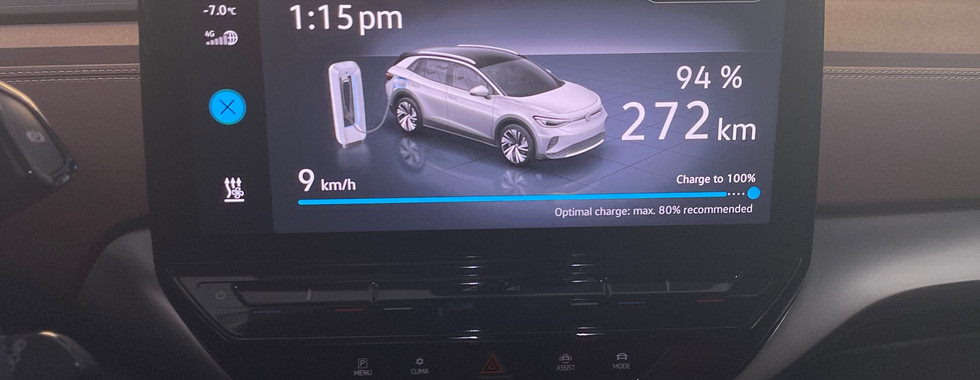VW ID.4 PRO S
- Marc Gonzalez

- Oct 10, 2022
- 5 min read
Updated: Oct 12, 2022
Electric vehicles are popping up left and right, and automakers must get creative to differentiate their products. Volkswagen is betting on its ID family to move the German company toward the future. In North America, the ID.4 is the first offering of the newer generation of electric vehicles. Let’s find out if the ID.4 is a competitive model; our test model has an MSRP of $62,735 and was built at the Zwickau plant in Germany.

The Volkswagen ID.4 has taken a different approach in terms of styling. The design team carefully made it stand out while not pushing too far, as most EVs have done at this point. The front grille is mainly covered; the only openings are found on the lower sides to improve the aerodynamics. In case you are wondering, there is an opening in the hood, but it contains an electric motor, so there is no front trunk or frunk. From a side view, the profile is not mind-blowing, but the effect of the roofline is attractive. The way the lines all meet up in the back is clever. The 19-inch alloy wheels are funky and help enhance the exterior design. In the back, subtle tail lights and a rear door are the main components. It’s focused on efficiency rather than styling in typical German fashion. Overall, the design of the ID.4 is straightforward and is aimed to please the broadest range of buyers.
Inside the vehicle, we found the interior underwhelming. The almost complete absence of buttons in the driver’s vicinity makes the ID.4 an ergonomic nightmare. For example, the window switches are only in front since you need to tap the rear button to control the back windows. Why complicate something so simple? Even the side mirrors operation is annoying. We’ll get into the rest of the convenience and interior aspects in a moment. Earlier, we discussed the lack of physical buttons on the driver’s door; there aren’t any buttons on the steering wheel or on the 12-inch central console. We found that the steering controls worked better than the ones on the infotainment screen, causing headaches when you want to lower the volume, for example. The complete lack of buttons is a mess; the rear defrost control is on the left side of the steering wheel, coupled with the max power front defogger and lighting controls. It isn’t good, especially in the winter, when parked outside and want to keep your gloves on.
Now to start the car; when you have the keys in your pockets, it will automatically turn on as soon as you sit in the driver’s seat. No need to push a button or anything, it’s a little unsettling at first, but you get used to it quickly. To put the vehicle into gear, you twist a knob on the right side of the driver’s screen; it’s the first time we’ve seen a setup to do the most basic and essential car function. To walk out, you have to tap the electronic parking brake button on the side of that knob and voila. The 5.3-inch display in front of the driver is relatively small and offers the very basics of the vehicle, such as speed, battery charge, range and a little graphic of the adaptive cruise control. The rest is monitored on the infotainment screen in the middle for basic stuff like trip information and battery charging time, so that’s a shame.
The infotainment screen was rather intuitive. The heated seat controls are easy to operate, and when you enter the Clima menu, you quickly get the different fan speeds and air directions. The overall screen also offered a clear image, and the placement is higher than on other products from the German automaker, which made for more practical use. As for the rest of the interior, the seats offer decent support but aren’t the most comfortable in their class. There is enough room to sit four adults, especially headroom with the large panoramic sunroof that spans almost the entire vehicle. The middle seat in the back isn’t obstructed by the transmission tunnel, keeping it usable. You could also pass through skis, thus increasing practicality. The trunk space is about what you can expect from a crossover of this size, not particularly large or small. Finally, installing child seats is straightforward, with clearly indicated ISOFIX ports on the rear seats and the rear anchor facing the trunk; you can easily sit children in the back, and they’ll have plenty of room to enjoy the ride.
In contrast with other EVs and other Volkswagen products, the driving dynamics of the ID.4 do not stand out. We hoped for a more engaging driving experience from the builder of the Golf GTI and Jetta GLI. On paper, the ID.4 Pro S AWD has a total output of 295hp and 339 lb-ft of torque from its two electric motor setup; the base model is rear-wheel drive only with its single motor mounted on the rear axle. The acceleration time announced by VW is 5.8 seconds. When you stomp the Play pedal on the floor, you feel the electric acceleration, but the feeling isn’t as pronounced. The vehicle is tuned to drive like a classic crossover, which means a vague suspension and handling coupled with a mild braking feeling and softer acceleration than other EVs. In a tight curve, you feel the weight of the car and the fact that the suspension is looser makes the car sway a bit more on the side. In urban areas, the handling is adequate, and parking is almost effortless, though be careful of the larger turning radius. This vehicle will be an excellent option if you prefer a smoother driving experience. Another complaint is the level of soundproofing which isn’t up to standard with the competition. Wind and tire noises are pretty apparent, especially at highway speeds.

A quick word on charging and range, the ID.4 Pro AWD has an estimated range of 410km; the RWD dual-engine version has 443km of range. We tested the vehicle during the cold months of winter and found that it had about 380km of range thanks to the heat pump on our test model. A quick side note, this car charged at night in a heated garage, so the battery didn’t need as much energy. The range indicator is, for the most part, accurate. We would’ve liked to see the battery percentage and not only the range. As always, you can charge on a 110V electric outlet (household) which would take days to charge from 0% to 100%. On a level 2 charger (240V), roughly an overnight charge takes about 7 ½ hours. And on a level 3 DC-fast charger (400V), the ID.4 can take up to 135kW of charge, and VW claims it can take under 40 minutes to charge to 80%. So in the winter, the range remains good thanks to its heat pump and 82kWh-sized battery.
In hindsight, Volkswagen comes with a new generation of electric vehicles with a timid approach in terms of styling, acceleration, and driving feel. Unfortunately, they tried too hard to revolutionize with the interior controls that aren’t buttons, and this is its most significant disadvantage. For the first few years, the ID.4 was imported from Germany by VW. US-manufactured cars will pop up in a dealership near you soon, and hopefully, you may get your hands on one of these soon.

VW has lent us this vehicle as a press vehicle. We have no affiliation with VW Canada. The above reflects our personal opinion.
















































































Comments